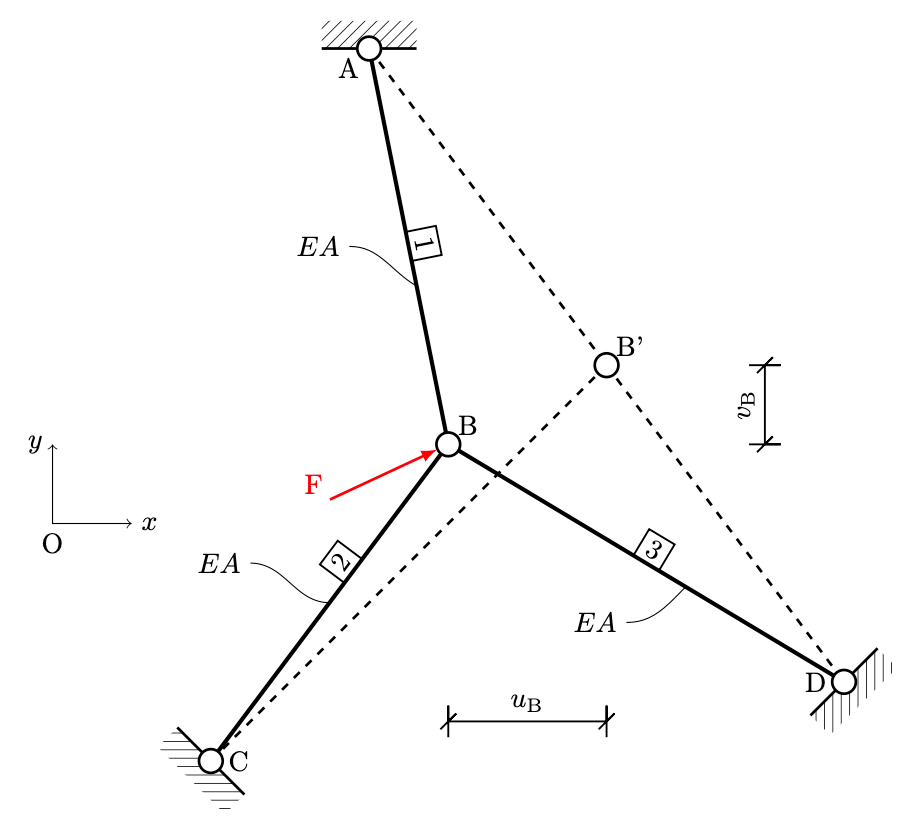The “Clebsh example”, a simple truss structure that A. Clebsh solved by the displacement method.
\documentclass[tikz,border=10pt]{standalone}
\usepackage{pgfplots}
\pgfplotsset{/pgf/number format/use comma,compat=1.16}
\usepackage[T1]{fontenc}
\usepackage[utf8]{inputenc}
\usepackage{stanli} % TikZ Library for Structural Analysis by Jurgen Hackl
\usetikzlibrary{calc,intersections,patterns}
\begin{document}
\begin{tikzpicture}[scale=1]
%\draw [help lines] (0,0) grid [step=1] (8,9); %useful for construction
% Coordinates system
\draw (-2,3) node[below] {O};
\draw[<->] (-1,3) node[right] {$x$}-|(-2,4) node[left]{$y$};
%point
\point{A}{2}{9};
\point{B}{3}{4};
\point{B'}{5}{5};
\point{C}{0}{0};
\point{D}{8}{1};
%beams
\beam{2}{A}{B}[0][0];
\beam{2}{B}{C}[0][0];
\beam{2}{B}{D}[0][0];
\beam{3}{A}{B'};
\beam{3}{B'}{C};
\beam{3}{B'}{D};
\notation{4}{A}{B}[1];
\notation{4}{C}{B}[2][0.6];
\notation{4}{D}{B}[3];
%supports
\support{3}{A}[180];
\support{3}{C}[-45];
\support{3}{D}[45];
%hinges
\hinge{1}{A}
\hinge{1}{B}
\hinge{1}{C}
\hinge{1}{D}
\hinge{1}{B'}
%load force
\begin{scope}[color=red]
\load{1}{B}[205][1.5];
\notation{1}{1.3,3.5}{F}[centered];
\end{scope}
%displacements
\dimensioning{1}{B}{B'}{0.5}[$u_\mathrm{B}$];
\dimensioning{2}{B}{B'}{7}[$v_\mathrm{B}$];
%labels
\notation{1}{A}{A}[below left];
\notation{1}{B}{B}[above right];
\notation{1}{B'}{B'}[above right];
\notation{1}{C}{C}[right=1mm];
\notation{1}{D}{D}[left=1mm];
\draw (0.5,2.5) node[left]{$EA$} to [out=0,in=180] (1.5,2);
\draw (1.75,6.5) node[left]{$EA$} to [out=0,in=150] (2.6,6);
\draw (5.25,1.75) node[left]{$EA$} to [out=0,in=225] (6,2.2);
% To-paths are really useful for drawing curved lines. The above
% to path is equal to:
%
% \draw[-latex,thick] (3.2,0.5) node[right]{$\mathsf{S_{1,2}}$}
% ..controls +(180:.2cm) and +(up:0.25cm) .. (3,0);
% Internally the to path is translated to a similar bezier curve,
% but the to path syntax hides the complexity from the user.
\end{tikzpicture}
\end{document}


